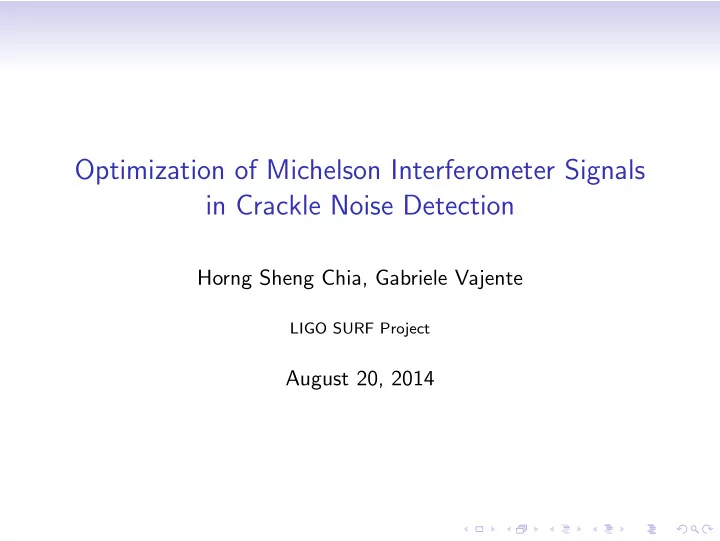

Optimization of Michelson Interferometer Signals in Crackle Noise Detection Horng Sheng Chia, Gabriele Vajente LIGO SURF Project August 20, 2014
Crackle Noise • Crackle noise may affect LIGO detection • Impulsive release of energy or acoustic pressure • Changes in geometry • Question: is crackle noise a problem to LIGO? Figure : Dahmen, Benzion, and Uhl, Phys. Rev. Lett. (2009)
Crackle Setup • Output: Difference between symmetric and antisymmetric port readings
Motivation • Crackle experiment is prone to noises: 1. Laser frequency noise 2. Laser intensity noise • Mirror misalignment also affects signal output • Coupling of noises can be minimized by adjusting parameters of setup • Before (Crackle 1 experiment): - trial and error - ideal parameters drift away due to environmental factors • Now (Crackle 2 experiment): - Goal: automatically adjust these parameters to optimize output • Simulation - MIST optical toolbox
Laser Frequency Noise • Variation of laser frequency • Laser Frequency Noise Coupling, g freq = ∆ L/ν • Aim: equalize macroscopic length difference, O(1mm) • Piezo-translation stage controls length of one arm Gain of Frequency Noise Coupled × 10 −18 [m/Hz] 6 Simulation Expected 5 4 3 2 1 0 0 0.5 1 1.5 Macroscopic Length Difference, [mm]
Laser Frequency Noise (Algorithm) − 17 x 10 4 Theoretical Laser frequency noise gain [10 − 17 m/Hz] Iteration Initial Final 3 2 1 0 − 1 0.31 0.315 0.32 0.325 0.33 0.335 0.34 Macroscopic Length of movable arm [m] • 100 measurements with random measurement uncertainties • Average of 5 steps to complete algorithm
Laser Intensity Noise • Variation of laser power • RIN = δP P • Aim: adjust microscopic length difference, O(1 nm) • Strategy: Locking (negative feedback) = ⇒ half fringe condition 3.5 SP AP ABS(SP−AP) 3 2.5 2 Power [W] 1.5 1 0.5 0 −0.5 −4 −3 −2 −1 0 1 2 3 4 Phase of movable arm [rad]
Mirror Misalignment • Effects of misalignment: (i) additional phase added by mirror misalignment (ii) shifted beam center = ⇒ reduced fringe contrast • Aim: align mirrors so fringe contrast is close to unity • Fringe contrast = P max − P min � � P max + P min = Re [ ψ 1 ψ ∗ 2 ] dxdy
Mirror Misalignment (Model) 2 L 2 2 α 2 + k 2 w 2 L 2 α 2 k 2 L 2 2 w 2 α 2 − k 2 w 2 α 2 • � � Re [ ψ r ψ ∗ o ] dxdy = e − − w 2 2 R 2 R 2 • L 2 = length of arm, w = beam radius, k = wavenumber, α = misalignment angle, R = radius of curvature of wavefront 1 Simulation Expected 0.9 0.8 0.7 Fringe contrast 0.6 0.5 0.4 0.3 0.2 0.1 0 −3 −2 −1 0 1 2 3 Angular misalignment of one mirror [mrad]
Gradient Ascent Optimization • Crucial parameter: step size • Divide fringe contrast pattern into approximate linear regimes grad x 1 grad y 1 grad local • δ = δ max grad max , where grad local = grad x 2 grad y 2 IV 1 V III II I Simulation 0.9 (0.256, 0.90) (0.177, 0.95) 0.8 0.7 Fringe contrast 0.6 (0.662, 0.50) 0.5 0.4 0.3 0.2 (1.21, 0.10) 0.1 0 −3 −2 −1 0 1 2 3 Angular misalignment of one mirror [rad] −3 x 10
Alignment Plots 0.7 1 X1 Y1 0.9 X2 0.6 Y2 Angular displacement [mrad] 0.8 0.5 0.7 Fringe Contrast 0.4 0.6 0.3 0.5 0.4 0.2 0.3 0.1 0.2 0 0.1 −0.1 0 0 5 10 15 20 25 30 35 0 5 10 15 20 25 Steps Steps
Conclusion • All 3 algorithms have been tested rigorously • Next step: implement in real crackle experiment • Acknowledge: Gabriele Vajente, Xiaoyue Ni, Alan Weinstein, LIGO SURF students, NSF • Thank You!
Alignment Plots 1 1 X1 Y1 0.9 X2 0.8 Y2 Angular displacement [m rad] 0.8 0.6 0.7 Fringe Contrast 0.6 0.4 0.5 0.2 0.4 0.3 0 0.2 −0.2 0.1 −0.4 0 0 5 10 15 20 25 0 5 10 15 20 25 Steps Steps
Recommend
More recommend